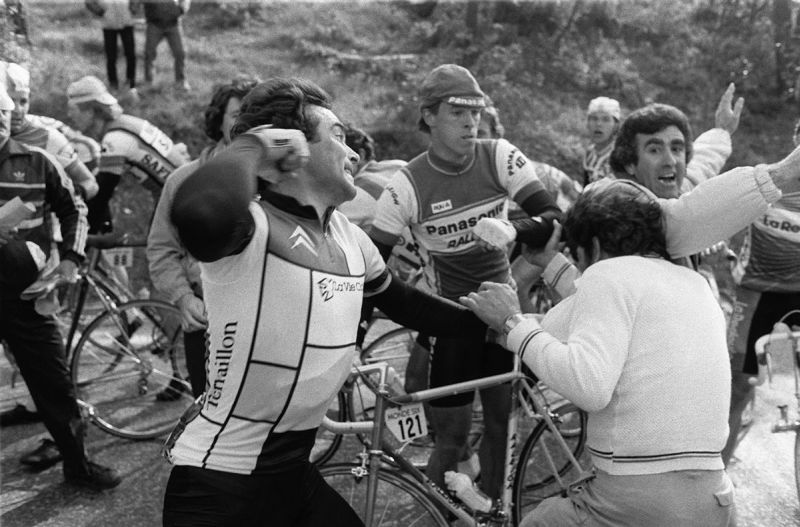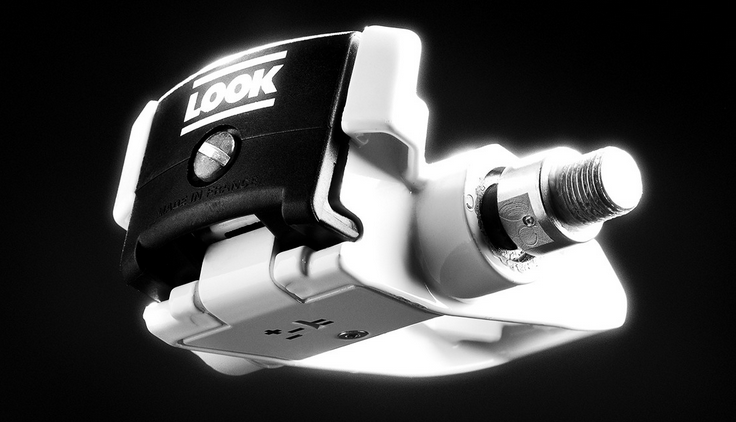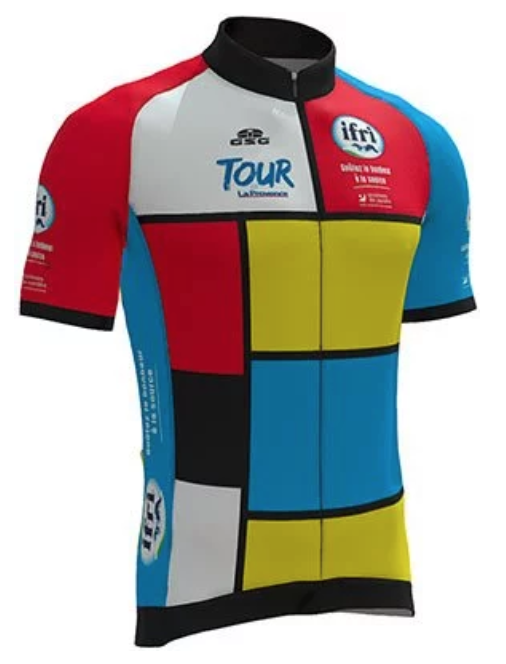Bernard Tapie has died aged 78. An businessman, a showman and briefly a politician, he was also a crook jailed for fraud and spent the last years of his life battling cancer and court cases. On his way up to the top in France he ran a major cycling team and helped bring about big technical changes in the sport, from pedals to salaries.
Born in 1943 Bernard Tapie grew up in a small apartment in the drab Parisian suburbs. Too poor to own a dog, the young Bernard said he found a fox in the woods and befriended it for nine years. He went on to train as an electronics engineer before compulsory military service. In 1966 he emerged to try a brief career as an entertainer, crooning under the stage name “Tapy”. It wasn’t a success and he deployed his charms to work as a door-to-door television salesman. With some knowledge of sales and electronics he then opened a shop selling consumer goods and this was the start of a long and lucrative entrepreneurial streak. One early venture was Cœur-Assistance (“Heart Aid”) in 1974 where subscribers could get emergency help in case of a heart attack but after the death of a client. he was taken to court in 1980. Brochures showed a fleet of ambulances, they had two and this was the start of many court appearances, trials and convictions. He was in court again after persuading a deposed African dictator that his many châteaux in France were going to be confiscated by the French state so he’d better sell them to Tapie quickly; Jean-Bédel Bokassa learned the story was a hoax and and took Tapie to court to cancel the sale.
In the wake of the 1970s oil shocks, France was trapped in an economic spiral of inflation and recession and here Tapie found his angle: he’d buy bankrupt companies and turn them around, charming customers and calming bankers along the way, often selling the revived business for tens or even hundreds of millions and earning the nickname Le Zorro du business. Manufrance, founded in 1865 as France’s first mail order company, sold guns, bicycles and more. Tapie bought the the brand for one franc only Manufrance struggled and couldn’t be turned around. Tapie tried with other firms including and Wonder, a battery company, Terraillon which made weighing scales, and the health food retailer La Vie Claire (“The Clean Life”), often firing staff and closing premises. He also bought Look, the company made ski bindings and just as skiers could clip boots into their skis, the idea was to do this with cycling shoes and replace the traditional toe clips and straps.
Tapie’s first venture into professional cycling was in 1983 when La Vie Claire sponsored the dossards in Paris-Nice in March, by September he’d signed Bernard Hinault to ride for the new La Vie Claire team. Hinault was the best cyclist around, able to win classics and grand tours alike, but had suffered in 1983 with his Renault team. A feud with legendary team manager Cyrille Guimard meant Renault had to pick between Hinault or Guimard. With Hinault nursing an injury, they went for Guimard, and besides they had Laurent Fignon on the books who had just won the Tour.
Tapie didn’t buy Hinault for one franc but there hiring a rider with a glorious palmarès now blighted by injury might have had its appeal. The La Vie Claire team was launched at the ritzy Crazy Horse nightclub in 1984. The jersey featured the Piet Mondrian design, radical in cycling but a copy of a Yves Saint Laurent cocktail dress. As explained in William Fotheringham’s Bernard Hinault, each of the primary colours represented one of Tapie’s businesses with Wonder, Terraillon and obviously Look featuring on the kit. As well as Hinault they signed Paul Köchli, then the Swiss national coach and an early adopter of sports science.

Hinault’s and La Vie Claire’s 1984 season wasn’t his best, a run of abandons, at Paris-Nice he was perhaps more famous for punching protestors. He struggled in the Dauphiné and after a win in the Tour de France prologue, finished second overall to Laurent Fignon but a distant ten minutes down. Tapie was along for the ride at the Tour and quietly – via a woman on a motorbike dressed in black leathers sent to collect LeMond – signed Greg LeMond as another GC contender for the following season.

Look didn’t invent the clipless pedal. But the firm delivered the PP65 model to the market, using Hinault’s notoriety as a marketing point. The La Vie Claire team were branded as a modern team with new ways and innovative technology. Look became the market leader and the leather toe strap redundant. The Mondrian jersey was stylish and there was substance too, until then sponsor logos had been sewn on to the kit but sponsor Santini delivered ready-printed jerseys. Look’s sales soared and as well as thriving ski bindings and bicycle pedals, they developed a carbon fibre frame in conjunction with aerospace firm TVT, the KG 86.
Tapie signed LeMond on a “million dollar” deal, a big headline but the sum was spread over the three years of the contract. LeMond was also promised a dollar for every pair of pedals sold in the US but speaking to L’Equipe a few years ago he said he never saw a dime. The contract was a big sum and marked a bout of wage growth in the sport. Was Tapie the cause? Arch rival Cyrille Guimard says non in a piece on Directvelo exploring Tapie’s role, adding it was the arrival of increased television coverage. Tapie though was the catalyst, the one who opened the doors to change the sport’s model and his gift for publicity and headlines meant paying a rider a big contract was a talking point rather than a secret and once riders knew what their rivals were getting wages got bid up. Hinault won the 1985 Tour and LeMond the 1986 one, and on the new KG 86 carbon frame.
Hinault retired early as promised while LeMond’s final year at La Vie Claire was a write-off following a broken wrist and then his near-fatal hunting accident. Tapie thought he might have a new star in Jean-François Bernard after he won both time trials in the 1987 Tour de France on his way to finishing third but that was peak Bernard. Irritated by the lack of results, Tapie even tried to buy rivals off, “he wanted to pay the breakaway to stop, or pay others to chase with us” team manager Yvez Hezard told L’Equipe. La Vie Claire stopped sponsoring and was replaced by Toshiba, but this was not the Japanese electronics giant, merely the French distributor in which Tapie had a hand. Tapie was leaving cycling behind and having bought Look for 1 franc he sold it to Swiss investors in 1990 for 620 million francs (about €100 million).
Tapie had become a household name in France. He had a TV show called “Ambitions” where he coached a budding entrepreneur in each episode – who says history does not repeat probably doesn’t watch television – but this was pulled after the French authorities said the show was more about Tapie than starting a business. Were some were worried about his growing popularity and influence, a political challenger and an outsider who hadn’t come up through the usual elite finishing schools? This was precisely what made him popular, he was a millionaire but spoke to those on the minimum wage and was happier addressing a crowd than a boardroom. He also had other sporting interests outside of cycling and another turnaround project was the football club Olympique Marseille which he’d bought in 1986. They went on to win the French league several times and the UEFA Champions League.
Tapie bought struggling sportswear brand Adidas too, hoping for another corporate fix but had to sell this when he went into politics but he didn’t last long, the government lost the next election and Tapie was out. “I went into politics rich and came out poor” said Tapie. Perhaps unusually for a telegenic businessman going into politics he was invited precisely because he was adept at taking on populists and extremists. His politics seemed more about rallying people rather than dividing them.
In his exit from cycling with tales of buying off riders and fix results some warning signs were there and it later emerged that Tapie had bribed rival players to help Olympique Marseille win the league and stay fresh for a Champions League game. He got a criminal conviction and jail in the 1990s.
On leaving prison, and banned from government and business, Tapie became a post-modern celebrity, famous for being famous. Theatre shows, a radio phone-in host, TV chat shows and more. He was even in a gangstère rap duo and also played the lead role in a TV series… as a policeman: which was more improbable, the millionaire businessman in a rap video or the convicted criminal playing a detective? He even had his own Guignols puppet, a sign he was a public figure (Richard Virenque had one too). Less light-hearted but he also sued the bank Crédit lyonnais saying they’d undersold Adidas on his behalf and in 2008 won a settlement of €400 million but this started a saga of court cases and litigation which he’d never live to see the end of.
Tapie returned to business, trying to turn around the Club Med holiday business but his raid was rebuffed. He had another go when he bought the Marseille media group Hersant and relaunched the La Provence newspaper. This brought him back to cycling as, like the days of old, the newspaper hit on using a bike race as a publicity stunt and the early season Tour de La Provence was launched in 2016. In a nod to the past it even revived a Mondrian-esque leaders jersey.

He fell ill with cancer of the stomach and oesophagus in 2017. His business dealings, court cases, criminal convictions and subsequent public rehabilitation entertained and intrigued many in France who saw him as an outsider who’d made it despite all the hurdles placed in front of him. He even cultivated the Edmond Dantès image of him as a modern day man from Marseille out for revenge on the scale of the Dumas epic. All of this eclipsed his time in cycling, La Vie Claire and Look is probably a footnote in his biograph although it did coincide with the rise in his popularity. His time in pro cycling was short but a lot happened and if some of it might have occurred without him given the changes in television and the rise of sport as entertainment and bike technology, Tapie was at the centre of it all with contracts, jersey design, sports science and bike technology.

Re Paul Koechli, when you say sports science do you mean sports science or ‘sports science’? As in Conconi/Ferrari sports science?
Sports science without anything loaded. Köchli was all about intervals, measured efforts and one of the earliest coaches to use a power meter etc and by all accounts, into clean sport. He was a rare voice who spoke out against doping when others went quiet and in the wake of the Festina scandal, denounced team doctors pretending to be coaches when they were really prescribing/administering products for performance. Anyway, that’s what was meant.
Cool, thanks
Interesting typo : it’s Jean-Bedel Bokassa and not Jean-Bebel, but Bebel is the nickname of another french celebrity, Belmondo. Is it a hidden reference to this extract of L’Incorrigible where Belmondo plays a crook who tries to talk in the same time to his charming probation officer (he’s just out from prison) and to an African general, trying to sell him some Mirages (fighter jets) ? https://www.youtube.com/watch?v=9YBrWt3iE5I
Hmm, no hidden reference but perhaps a slip in the wake of Belmondo death too. He was a big cycling fan in his spare time. Coincidentally his first break in cinema came when he played in “Un Singe en Hiver”, written by Antoine Blondin who was for the best part of 30 years L’Equipe’s cult columnist for the Tour de France.
An engaging read as always. One small typo: “Hinault won the 1986 Tour and LeMond the 1986 one” – Hinault won in 1985.
That era was when I was first getting into cycling, and La Vie Claire (or more rightly the jersey) made a big impact – I had a poster of Hinault in full flight on the way to victory in the 1984 Tour of Lombardy on my wall, rather than any pop star. Subsequently Tapie’s other life came into focus, but he’ll always be the man who saved Hinault’s career to me, rather than associated with Olympique de Marseille or any of the later political and financial scandals.
The piece above was long enough so thoughts about Hinault’s options then got chopped but you’re right about saving Hinault’s career, he seemed to have few options at the time and move to Italian team Malvor seemed likely, but that would have been a step down to a small team with less support. Tapie was able to create a new team with Hinault knowing that he’d probably get a lot of sponsorship money back just from having Look sell all those pedals. And yes, he was back come the end of the 84 season with the Baracchi win (with Moser) and then Lombardia.
Very interesting read, as befits the man in question.
He certainly lived a full life.
I found an 80s Mondrian-influenced number that you can just imagine Tapie dancing the night away in a smokey French discotheque with one of those blondes in his company, RIP –
https://www.youtube.com/watch?v=N26FAa0ySQ4
I always thought of La Vie Claire as the dividing line between cycling eras. I remember watching Urs Freuler winndull stages in those awful Atala jerseys, then noticed La Vie Clarie and saw something I’ve never seen before in a bike race. But, it was more than the now iconic kit, they also had a multinational roster of riders, a Swiss DS all on a French Team. The sport looked and felt different once the hit the scene. The La Vie Claire’s ‘86 Tour is still on of the most dominant performances in Tour history.
People, including this blog, often hold up the 1989 and 1964 Tour de France as vintage editions but 1986 must be in many people’s list of top-5s, top-10s too.
and I liked the Atala jersey. Retro before its time, even if it had a faint jailbird look!
Strangely, my French partner – and much of France – finds Tapie sympathetic despite all the evident flaws. I can’t see him as anything other than a fraud with lots of bluff in the Maxwell (Johnson?) tradition. Cap’n Bob even dabbled in sport too. It still astonishes that (nominal) socialist Mitterand had him as a minister though, I suppose, Mitterand was knowingly appointing popularity rather than competence and diligence.
The Look clips were a real breakthrough though. Who can remember tightening Binda straps on Christophe clips to climb or sprint, and almost cutting off circulation?
Interesting is how little the pedals seem to have changed, they’ve been refined but it’s still a hook on the front and a plastic clip on a spring at the back. There have been other models but Campagnolo doesn’t make pedals any more, Speedplay has a Niche and Shimano’s got SPD but even their road pedals based on the Look model.
By the sounds of things the Mitterand regime was on the way out and the government needed some fresh ideas in a hurry. Tapie took part in a TV debate against the far right leader Le Pen and, in an age when TV clashes weren’t a fixture, demolished Le Pen with some verbal traps and quick one liners. It was if someone had found away to stop the populist politician in his tracks.
Nobody ever mentions Time pedals (sob).
When I was briefly living in France in ’99 I saw an interview with Tapie on “Nulle Part Ailleurs” (the show which played host to Les Guignols, and that wonderful Virenque running gag). I remember his charisma being off the charts – the Trump comparison is accurate and who knows, maybe if he was born a few years later he could have reached similarly unlikely political heights.
Had no idea about his cycling connections, but then he certainly had a lot of fingers in a lot of pies.
1985 was the year that I first saw a bit of cycling via dramatised highlights of the TdF on the Wide World of Sports. The drama was over whether Lemond should follow team orders after Hinault had an off.
This last week also saw the passing of the last of Australia’s takeover merchants. The past is definitely receding very quickly.
Ironically, this winter will feel like the 1970s all over again, if that’s any consolation.
He was a horrible crook that made his money through bribery and by buying up companies in receivership and stripping them of their assets, leaving thousands of employees out in the cold. He also left his grandmother who raised him in poverty while he bought himself new yachts.